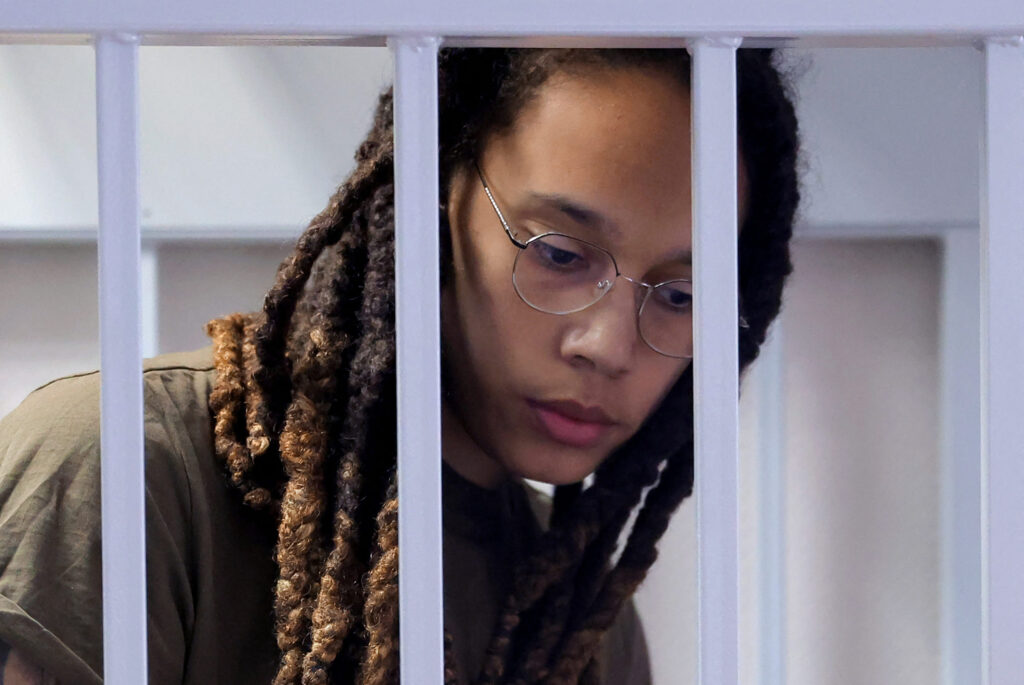Brittney Griner returned to the United States on Friday after 294 days in custody in Russia.
The WNBA star was freed in exchange for the release of Russian arms dealer Viktor Bout. The swap brought an end to Griner’s imprisonment, which began nearly 10 months ago when Griner was arrested in a Moscow airport for alleged possession of hashish oil.
Just Women’s Sports kept a a timeline of all the updates in Griner’s case, and here we break down everything you need to know about her detainment and her release.
When was Griner detained?
Griner was arrested Feb. 17, although that did not become public knowledge until March 5. The Phoenix Mercury center had been traveling to rejoin her Russian club, UMMC Ekaterinburg, during the WNBA offseason.
Why was Griner traveling to Russia?
As Just Women’s Sports’ Eden Lasse writes, WNBA players often head overseas in the offseason. They attempt to make up for the U.S. league’s low salaries and short season by playing for European clubs.
In Russia, players have the opportunity to earn high salaries, which for top players could reach seven figures. Stars such as Sue Bird, Maya Moore, Candace Parker and Diana Taurasi have spent time with UMMC Ekaterinburg in past seasons.
During Griner’s trial in August, her club advocated for her release. Both players and club officials testified on her behalf, calling her contribution to Russian basketball “invaluable.”
Why was Griner detained?
The 32-year-old was accused of possessing less than a gram of cannabis oil, which she said in her trial she did not intend to bring with her into the country.
In Russia, possession of less than six grams of cannabis is supposed to garner no more than a fine or up to 15 days in jail. Instead, Griner was subject to a criminal trial, one which U.S. officials derided as a sham.
She was sentenced to nine years in a Russian penal colony. The guilty verdict was expected, as more than 99 percent of Russian court cases result in a conviction.
Why did it take so long for the U.S. to negotiate for her release?
The negotiations for Griner’s freedom hinged on the fraught diplomatic relations between the two countries.
Before and during her trial, Russia issued many warnings to the United States about the high-profile case, saying that they wanted a potential prisoner exchange to happen “without fanfare.”
The Russian government refused to negotiate with the U.S. government until Griner was convicted. Her trial started in June, with the verdict coming on Aug. 4.
After that, Russia said it was “ready to discuss” a swap. In response, the State Department urged the Russian government to accept a proposal the U.S. had offered in July.
In October, the State Department said there were “active discussions” about a swap. Still, officials did not expect to get a deal done ahead of the U.S. general election in November, as many believed Russia did not want to give U.S. President Joe Biden a perceived political win.
Following the election, talks seemed to have stalled. Griner was moved to a penal colony in early November, with her location unknown for several weeks. The Russian government later revealed that she had been moved to one of Russia’s harshest penal colonies.
On Nov. 18, Russian officials made comments indicating their willingness to make a deal, the State Department said Russia still would not “seriously negotiate.”
Within the last few weeks, Russia finally made their own offer: a one-for-one swap of Griner and Bout. While U.S. officials initially had hoped to include former U.S. Marine Paul Whelan, who also is detained in Russia, in the exchange, President Biden opted last week to make the deal.
Griner was moved to a Moscow jail Monday, her legal team said. After that, there was “complete silence” until word came Thursday morning that Griner was on her way to an airport, ESPN reported. Griner was flown to Abu Dhabi, where she was placed in the custody of U.S. officials.
What happens now?
Griner landed in the United States early Friday morning in San Antonio, Texas.
There, she’ll undergo a routine evaluation at Brooke Army Medical Center. The medical center, located on an army base, has long been somewhere the U.S. government sends people who need to be debriefed or require sensitive medical care. Both civilians and military personnel who have survived torture or other trauma undergo treatment at the hospital.
Whenever she is ready to leave the hospital, Griner will get to decide what happens next.











